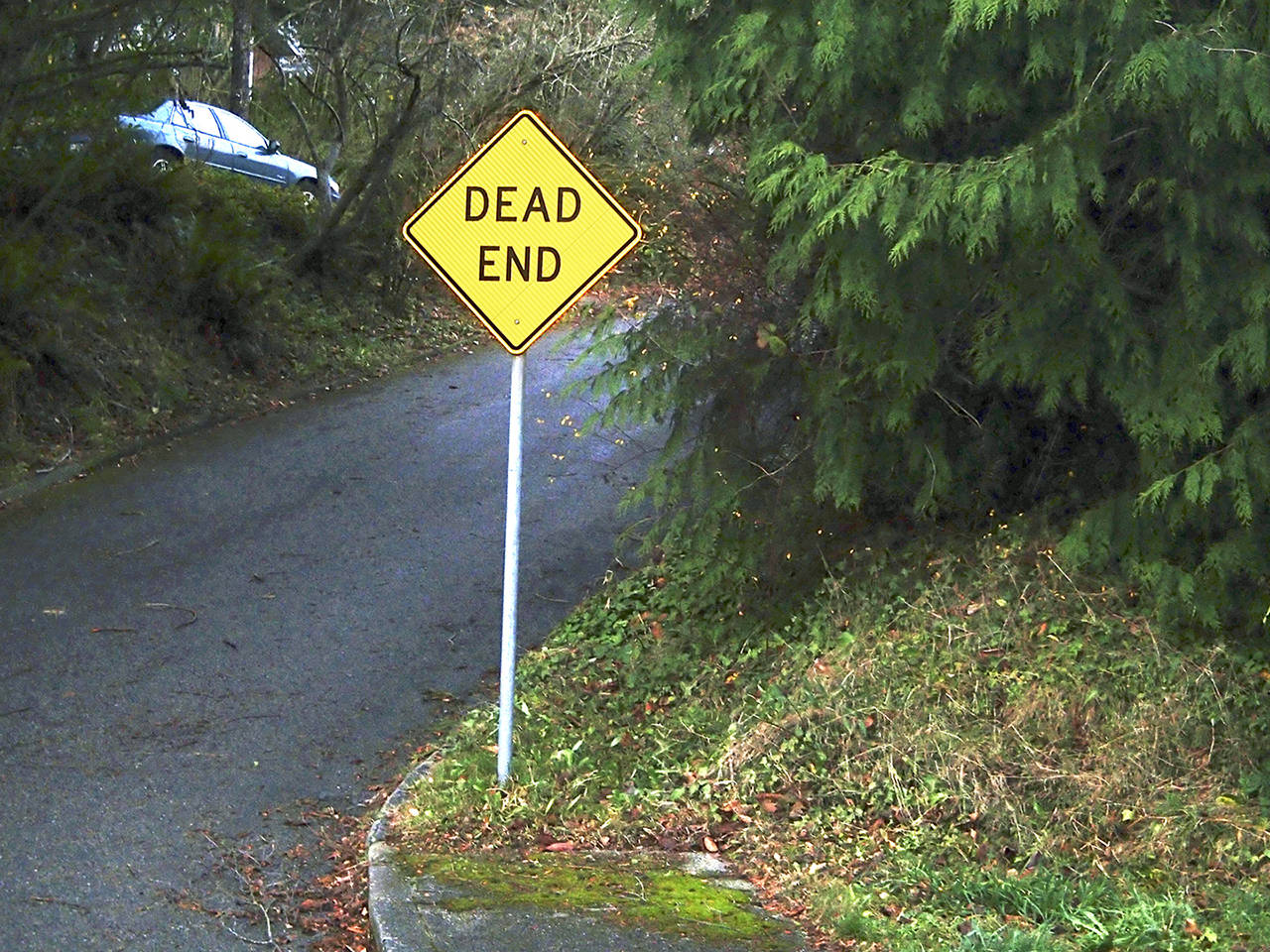Jim Larsen, of Langley, asked: “Are ‘No Outlet’ signs slowly killing off ‘Dead End’ signs? I’ve worried about this for years. Haven’t seen a new Dead End sign installed … Maybe the term Dead End creates anxiety.”
Turns out Larsen was on to something.
I asked local public works departments about their practices: Did they still use “Dead End”? Is there a stigma against the sign?
Most city staff gave the engineering equivalent of a shrug, by citing chapters and verses from the transportation bible that is the Federal Highway Administration’s Manual on Uniform Traffic Control Devices.
They follow the common practice of using both types of signs: “Dead End” at the entry of a single road that has no other exit; “No Outlet” at the entry to a network of roads that have no other exit.
However, a careful reading shows cities could use “No Outlet” in both situations.
And Arlington, Lynnwood and Edmonds are among local cities killing off “Dead End.”
Arlington switched to using “No Outlet” exclusively about nine years ago, finding it to be a better description, Public Works Director James Kelly said.
Lynnwood also favors “No Outlet.”
“The idea was that ‘No Outlet’ was a more pleasant sound versus ‘Dead End’ and keeps things uniform throughout the city,” city spokeswoman Julie Moore said.
Edmonds takes it a step further.
The city has been replacing its “Dead End” signs with “Street Ends.”
“It’s got the ‘dead’ word in there. We wanted to pull away from that,” transportation engineer Bertrand Hauss said.
(Turns out “Street Ends” is fine, even if it doesn’t appear in the manual. There’s wiggle room for warning signs. Though some may call that heresy.)
This has been going on for awhile. Over a decade, for Edmonds.
You could say it’s all part of lingering angst in the national psyche.
History lesson!
“Dead end” has etymological roots in an 1800s plumbing term.
The term has been used metaphorically since the 1920s, as noted by the late New York Times columnist William Safire in a 2008 column.
It was Sidney Kingsley’s 1935 play “Dead End” (later made into a film starring Humphrey Bogart) that “dramatically put together the street sign and the idea of lives with no upward mobility likely — bleak futures in an unfair society,” as Safire put it.
The bleakness stuck. And “Dead End” signs started disappearing in some cities.
More cities kept them, however. And you will still find “Dead End” signs in Sutton Place, the New York City neighborhood that inspired Kingsley’s play.
The federal manual that offers guidance on signs steers clear of such emotional baggage, of course. (It’s more concerned with shapes, caps lock, and the color yellow.)
Dead end signs have been around since at least the 1930s. The manual came around in 1935. The section on dead end signs, however, didn’t appear until the 1971 edition. A whole host of signs were added that year to the national how-to as part of a significant rewrite, according to history compiled by H. Gene Hawkins, an engineering professor at Texas A&M University.
At that time, the manual lumped together “Dead End” and “No Outlet,” noting they could be used interchangeably.
The current language didn’t come until the 2000 edition, a millennium effort that aimed to (ostensibly) clean up a whole bunch of confusing language.
The living and the dead
Like language, sign decisions also shift over time.
Snohomish has some “No Outlet” signs at the entry of single roads that have no other exit, but in new situations uses “Dead End.”
Langley has both with no policy preferring one over the other.
Stanwood leaves the decision up to developers.
“I don’t think we even have a ‘Dead End’ sign,” Darrington Mayor Dan Rankin said.
But if he were to choose for his scenic small town, Rankin said he’d go with “No Outlet.”
“I don’t see a debate in that. It’s a better description,” Rankin said. “And probably easier to translate if you were not fluent in the English language. … ‘Dead’ and ‘End’ — that doesn’t sound like a good outcome. We’re not going there no matter how beautiful it is.”
Melissa Slager’s last day at The Herald was Dec. 21, after more than four years as the Street Smarts reporter. She has several columns banked that will run in the coming weeks.
Talk to us
> Give us your news tips.
> Send us a letter to the editor.
> More Herald contact information.

























